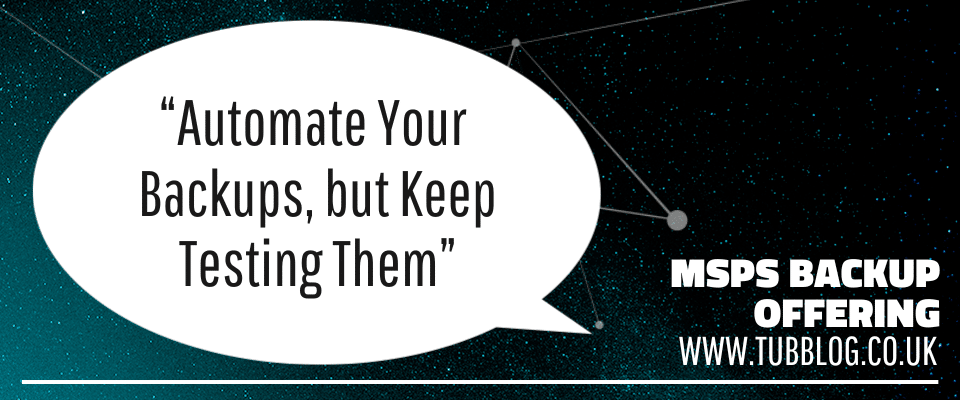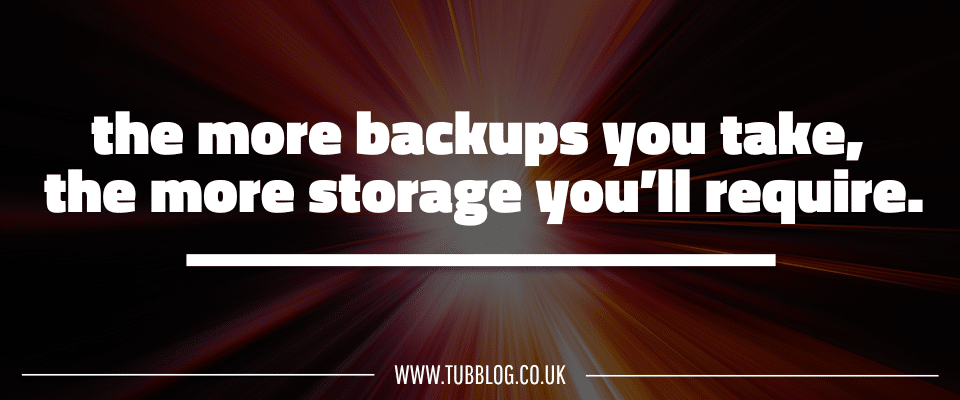
In appreciation of World Backup Day on the 31st of March 2024, we present a guide on the 7 essential ways to strengthen your MSP’s backup offering. Whether it’s something your MSP offers already or is considering.
What is a Backup?
Backup is the process of creating a copy of your secure data to be used for recovery in case your data is lost or corrupted. Backup is often linked to Disaster Recovery and Business Continuity as the purpose of a backup is to ensure you have the ability to recover quickly from any loss of data.
Types of Backups
Backup solutions today come in various guises, depending on what you want and how you want it.
Here are some common examples of backup and how they work:
Full backup – This is a complete copy of your system files. It’s recommended you have a full backup to start with in any solution you have, but a full backup does take a lot of time.
Mirror backup – is similar to a full backup, but it’s a direct mirror of the source data. As this is the case it only ever keeps a direct copy with no version history. Disk mirroring is sometimes referred to as RAID-1.
Differential backups – Only backup files that have changed since the last full backup. Over time, differential backups grow in size until another full backup is performed.
Incremental backups – Similar to differential backups, they backup data that has changed, but this can be from any backup – not just full backups. Though this kind of backup takes less time to perform than the other two, it requires the most amount of time to restore from, as you have to restore from the last full backup and each incremental backup in turn.
For a full reference, as well as different backup solutions and vendor offerings, this guide from cybersecurity experts Acronis provides greater detail.
Backup Tip #1 Having a Tiered Backup Offering That Demonstrates Increasing Value to the Client
Depending on the client and their needs, you may find that they require a more robust solution for their backup. While most cloud software solutions back up the data internally, restoring quickly can be a challenge, and the loss in downtime could seriously harm a business and its reputation in a result of a cyber-attack, for example.
As an MSP, you’re offering security for your client’s data, but you’re also offering the convenience of recovery too.
That’s why offering a tiered approach to your backup services allows you to sell the benefits of a full business continuity package with peace of mind for your clients. Especially in these times when cybercrime is at an all-time high.
Positioning your three tiers and getting it right is the key. But you’re likely to be offering a core service, one with increased emphasis on disaster recovery, and a level based on added granular recovery options and quick turnaround times. These are likely to be called something like:
- Backup Essentials or Core
- Backup and Disaster Recovery, and
- Business Continuity Plus
Backup Tip #2 Choosing the Right Backup Vendor for the Clients and for your MSP Offering as a Whole
It seems obvious that you need the right tool for the right job, and the same is true of the vendors you select as well.
Depending on how you’re supporting a number of clients, you may have backup vendors for a great number of different products. Managing all of these can be difficult, but there are some tips here to make that a little bit easier.
Make sure that whatever you’re backing up can be accessed and reported on from a single consolidated platform. That includes any remote devices, cloud data, and on-premises backups.
Make sure your backup vendors of choice are MSP-focused. Some vendors work directly with small to medium-sized businesses or deal in other channels. However, MSP-focused vendors will provide the tools that meet the needs of a managed service provider, because it’s what they do.
Make sure that along with backup, the vendor is focused on speed of recovery. This is sometimes referred to as a Recovery Time Objective (RPO). A vendor that can provide a faster recovery means lower downtime in the event of data loss, however, this can be expensive if lower downtime is a high priority for your typical clientele.
Backup Tip #3 Ensuring that Recovery is as Accessible and Granular as the Customer Requires
If you want to be able to recover a small part of your data, instead of restoring a full backup, this is possible with certain granular recovery configurations. The ability to restore a single corrupted mailbox, rather than a system-wide restoration, is much more convenient.
This level of complexity comes at an additional cost, but it drastically reduces recovery time, which many businesses are happy to pay a little extra for.
Backup Tip #4 Factoring in the ‘Maximum Tolerable Downtime’ Requirements of the Client
While the ideal is that downtime during an incident of disruption is kept to a bare minimum, it’s worth having the conversation with clients as to what the maximum tolerable downtime (MTD) is for their business.
This is the total amount of disruption a business can allow before incurring potential loss of business or reputational damage.
We’ve mentioned already the Recovery Time Objective (RTO) metric, but MTD is calculated using this plus another element called Work Recovery Time (WRT).
In brief terms, WRT is all the actions that need to take place once the disaster recovery plan is put into action to get the business back to full operating capacity again. If there is a lot to reset during the restoration process, this will affect your overall MTD.
Therefore, reasoning this into your sales pitch is something every MSP needs to be aware of.
Tech Target has a great guide on this subject if you want to find out more: How to Calculate Maximum Allowable Downtime.
Backup Tip #5 Compliance and Insurance Coverage Considerations
Many cyber insurance providers are insistent that those looking for cover are doing as much as they can to mitigate their losses in the event of a cyber-attack. One of those things is to have adequate systems in place, such as backups, to protect your data if held to ransom.
Likewise, for compliance with GDPR, you are required to back up and protect your data as a business. Therefore, you may mention this to your clients when selling them a backup solution. This article from Backup Systems Ltd highlights the compliance requirements in more detail: 6 GDPR Implications on Data Backup and Disaster Recovery.
Backup Tip #6 Automate Your Backups, but Keep Testing Them
Once you have decided upon a backup solution, you will want to get this automated as much as possible. This is so that you can focus on new projects and your day-to-day business.
However, as an MSP owner, you should be testing them whenever updates or new software is added to the stack. This commitment should be agreed upon with your client and clearly outlined when signing them up for a backup solution.
Even if nothing has been added or reconfigured for a while, regular testing should still be scheduled regularly for a ‘belt and braces’ approach.
If a backup is corrupted, you don’t want to discover this when you attempt a restore at a critical moment.
Backup Tip #7 Ensure a Backup is Kept in a Different Physical Location to Your Main Data Store
A Disaster Recovery Plan (DRP) is a formal document created by an organisation for emergencies. It contains detailed instructions on how to respond to unplanned incidents such as:
- Natural disasters
- Power outages
- Cyber attacks
- and other disruptive events
That organisation needs to minimise the impact of such disasters to ensure it remains able to resume function as soon as possible.
If your backup is stored in the same physical location as your other data, and that building suffers a catastrophic fire, for example, your business is practically finished. The data will be lost and the damage to your business will be catastrophic.
Housing your backup in a different physical location gives your business peace of mind if the worst were to happen.
Other Tips for Backup-Focused MSPs
Aside from the 7 tips above, there are other considerations for your Backup offering as an MSP.
Number of Backups in Storage
The more backups you take, the more storage you’ll require. However, it’s always prudent to take extra backups. There are two reasons for taking additional backups:
- In case one of the backups somehow becomes corrupted, or
- In case you want to restore from further back in your data history, (which is especially useful for granular backups).
Smart Backups
AI is becoming increasingly versatile in IT applications. Algorithms determine when a new incremental backup is required, based on behaviour rules set to precise parameters. This is particularly handy if your client’s data infrastructure is a complex one.
Backup/Restore Testing as a Service
For extra piece of mind for the client, ensure that backup testing features as part of their contract. It might seem obvious, but you should create a ticket each time you do this, as with any billable item.
World Backup Day – 31st March 2024
World Backup Day is a day to highlight the importance of protecting your data from loss or theft.
Find out more about it by visiting the World Backup Day website.
There are some fascinating, and somewhat frightening statistics, including:
- 21% of people have never made a backup
- 29% of data loss cases are caused by accident
- 30% of all computers are already infected with malware
On March 31st, observers of World Backup Day are encouraged to take the pledge to create at least one backup of their data
Take the #WorldBackupDay pledge: “I solemnly swear to back up my important documents and precious memories on March 31st”.
Conclusion
Backup-as-a-Service is a powerful tool that MSPs can easily provide to their customers alongside their other offerings.
A good backup solution can help a business with its business continuity and compliance needs. Understanding a client’s need for minimal downtime or granular restoration can help you sell a best-fit solution.
Ideally, you’ll want to make backup a simple service. Or one that is easily configurable to multiple configurations, if you have a range of clients.
It isn’t just cyber criminals that are responsible for data loss in your business. Anyone can make a mistake, and there are increasing pressures on business to protect their data. So, it’s worth looking into a robust backup solution if you don’t have one in place already.
There is no ‘one-size-fits-all’ when it comes to backup solutions. It all comes down to what works for you and your clients’ data ecosystems. The important thing is to keep your data protected, backed up, and within easy reach if you need to restore it.
As an MSP, it’s easy to practice this for your clients, but many IT providers haven’t got adequate backup solutions in place for their own business. Too many refuse to ‘eat their own dog food’ when it comes to security and backup solutions.
Could your backup offering benefit from some of these suggestions? We would love to hear about it in the comments.






















Comments